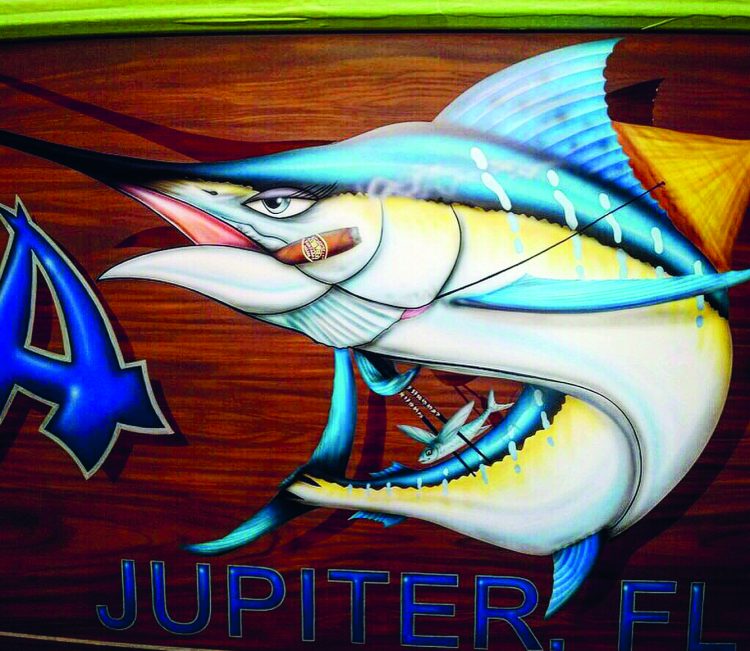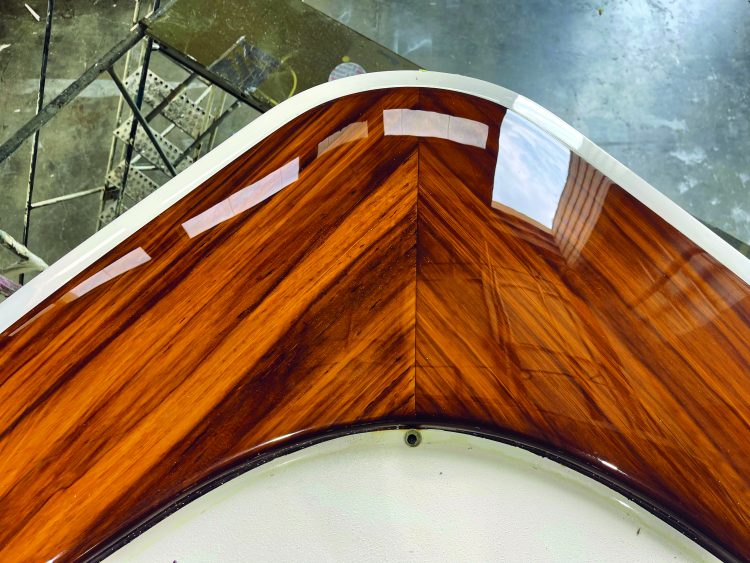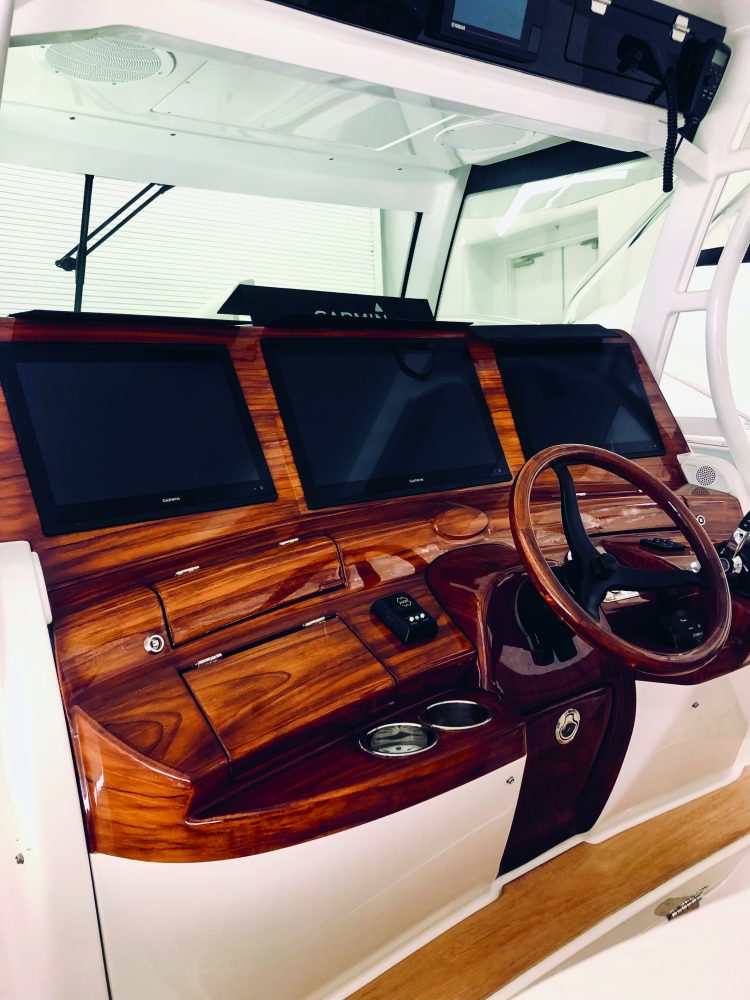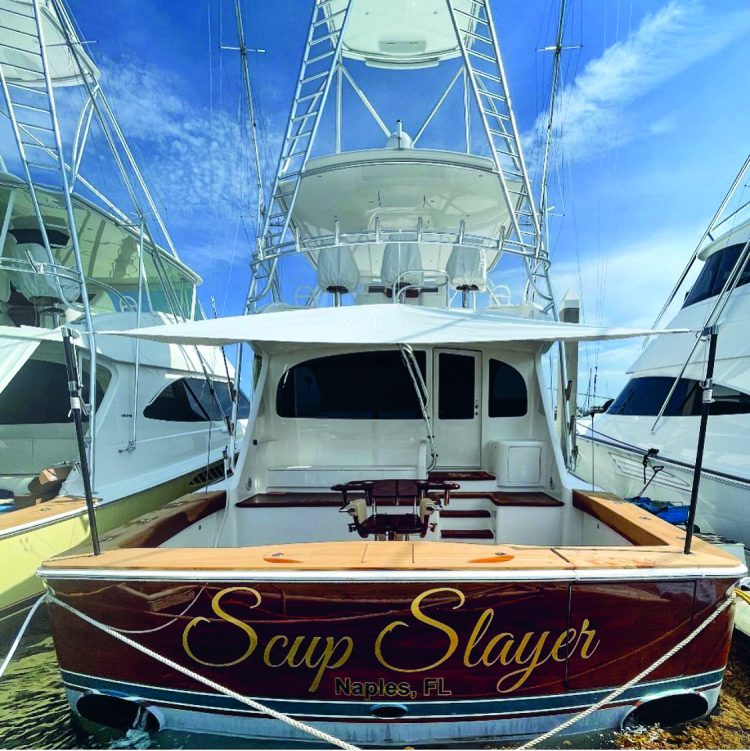Angling Artist: Louis DeFusco
DeFusco's realistic faux-teakwood artwork gives fiberglass boats of today an old-school nautical appearance.

At first glance, my reaction to Lou DeFusco’s faux teakwood art was: “There’s no way that’s not wood.” I suppose it’s exactly the reaction he wants his clients and fellow watermen to have when they lay eyes on his work.
A true blue-water fanatic, when I spoke to DeFusco, he had just returned from a vacation to Panama chasing powerful exotic species (by New England standards) like roosterfish and cubera snapper. While fishing vacations have taken him to places like that, DeFusco’s artwork has allowed him to travel around the country, and beyond, to brighten up fishing vessels large and small with his detailed replicas of teakwood grain.
DeFusco’s art reached the marine world only five years ago, when he noticed there was a demand for faux-wood artists in the boating industry. Boatbuilders could no longer easily source teakwood—a tropical species of hardwood known for its durability in furniture and shipbuilding since the Middle Ages— so manufacturers began seeking alternatives. DeFusco, who was raised on the water since the age of 10, grew up with a knack for marine art. He painted and illustrated fish for much of his childhood before pursuing art education at Rhode Island College and, later, the prestigious Rhode Island School of Design. In school, his studies were focused on sculpture and learning how to manipulate rigid materials (such as metal) through sheet welding them into abyssal sea creatures such as lanternfish, scorpion fish, and hatchet fish.
After receiving his college degrees, DeFusco worked in restaurants and houses painting faux woodgrain and spent 20 years as a charter captain out of Point Judith, Rhode Island, where he guided clients to the tuna grounds for bigeye and yellowfin tuna. When he wasn’t immersed in the madness of jig-and-pop tuna fishing, DeFusco motored offshore to deep-drop for tilefish and swordfish. He told me he was magnetized by the open water, citing that he most enjoyed offshore fishing because each day was like a puzzle that required anglers to solve it in order to succeed. Ironically, his faux teakwood art is similar in that each painting requires a different approach; his canvas size is everchanging and so are the offshore conditions.

As one of only a half-dozen faux teakwood artists in the marine industry nationwide, DeFusco’s work is in high demand. His first nautical woodgraining job was on a 92-foot Viking that travels seasonally between Newport and Palm Beach, Florida—a nerve-wracking undertaking for an artist at the starting gates of his young career. His step-by-step painting process has changed over the years, but as long as he has a fiberglass canvas, DeFusco is confident in his current 8-layer process for vessels of any size.
Most of DeFusco’s work is done in an open-door warehouse, so he begins by sanding the area he plans to paint and then using masking tape around it to protect from the elements and keep it in good condition. He then applies two coats of Awlgrip marine paint— one layer that is hand brushed and an airbrushed subsequent layer.

DeFusco uses brushes of different sizes, stiffness, and bristle length that he manipulates to acutely detail every grain. He noted that the most challenging part of painting the grain on larger vessels is trying to keep his wrist straight to maintain a sturdy and straight pattern for the most natural look. He then applies a second coat of paint with an airbrush, which gives life and deeper color to the hand-painted grain. Finally, the painted layers receive five clear coats of a UV-protective epoxy before the vessel’s name is painted over it in gold- or silver-bolded letters. The finished product is a boat with a regal and inherently old-school nautical appearance, much like the ships constructed of teakwood hundreds of years ago.

Drawing more comparisons to jig-and-pop tuna fishing, DeFusco insisted that after a hard day’s work, his arms are toast. The precision and fine attention to detail in creating these remarkably natural patterns leave little room for error, meaning tensed muscles for hours on end. Like an eager angler waiting to cast into a feed from the bow, there is an unseen intensity beneath DeFusco’s calm demeanor.
Like each day in the canyons, every boat he’s worked on has a learning curve, and DeFusco is always aiming to improve the finished product. He is currently contracted with Viking in New Jersey and, more locally, Boston Boat Works, where he is working on 15 Day Chasers as they are built, allowing him plenty of repetition to further perfect his craft. During the winter months, the days that tuna junkies fear most, DeFusco takes his painting skills to warmer locales like St. Petersburg, Florida, and Costa Rica, where he continues his work. He looks forward to vacation time in July and August each year, when everyone’s boats are in the water, giving him the chance to run offshore again, where he just might recognize some of his own artwork painted across the stern of a neighboring vessel.
Instagram: @lou_defusco
Leave a Reply